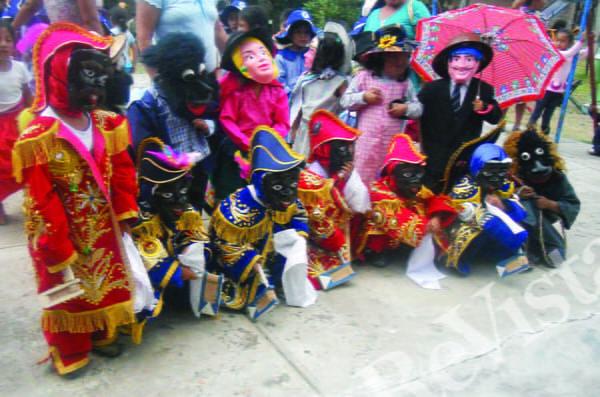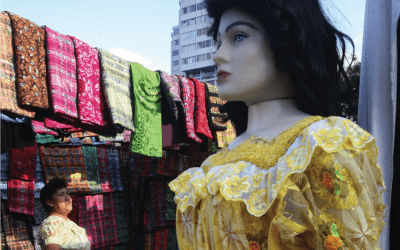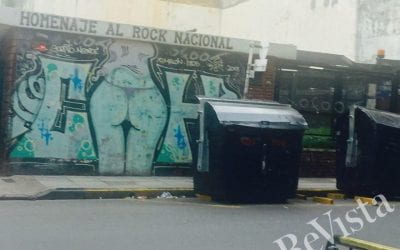Performing Race and Gender in the Andes
Llarqa Aspiy
Right after attending my first llarqa aspiy celebration in November 2012, I jotted my description of this lively event in my fieldnotes: “We stood in a large circle, passing cristal beer and a small plastic cup, nodding our heads in time with the music. The costumed figures in the center whirled around and around, characters in black-face masks tirelessly hopping in something like an Irish shuffle, their hairy, huge-headed chapo counterparts cracking whips.”
Llarqa aspiy, the clearing of communal drainage ditches followed by celebration, happens during the dry season in Ayacucho, Peru. And while I attended ten such parties during my fieldwork in the northern subdistrict of Huanta in 2012 and 2013, it was a continual source of fresh wonder: the dancers whirled for hours, pantomiming elaborate, sexual scenes of kidnap and release, dressed in elaborate costumes with black-face, brown-face and white-face masks. Not realizing, initially, the relevance this performance had for my research, I attended primarily to see what the people I was interviewing did for fun.
I was in Ayacucho studying what women did for a living and how they coped, as part of an ongoing study study on the political involvement and labor strategies of landless, single mothers. In keeping with much of the literature on women’s experiences in the Global South, I found they struggled to get work, representation and, sometimes, basic resources for their families. Joining friends at llarqa aspiy, however, I eventually realized that celebration illustrated very different dimensions of local social life. With its unusual depictions of desire and availability, llarqa aspiy taught me a lot about particular Andean concepts of race and beauty. Specifically, the portrayal of racialized difference in llarqa aspiy highlighted indigenous women’s sexual agency, subverting the neocolonial gendered and racial hierarchies commonly seen in the region.
Rural Ayacucho is a surprising place to examine humor, if not subversion. Best known as the birthplace of the Shining Path communist guerilla organization (PCP) and epicenter of violence during the decades of violence between the PCP and the Peruvian military, it was the site of horrific warfare in the 1980s and 1990s As violence exploded in the highlands, many scholars working there fled, along with local families. Since returning, anthropologists have focused on attempts at healing and rebuilding, outmigration and return and the growth of coca production in the VRAEM (Valley of the Apurimac, Ene and Mantaro Rivers). A geopolitical region in the border area between Ayacucho, Cusco and Apurimac, the VRAEM is currently the largest site of coca production in South America.
With the stakes of racial and class-based divisions made forcefully clear, many Andeanists also focused on the identity politics affecting this rural experience, of social tension in the region. Scholars have documented the racist attitudes white and mestizo Andeans displayed towards indigenous citizens and the silencing of indigenous women, in particular, within patriarchal family and community hierarchies. Many have found Andean women are victims of physical and verbal violence perpetrated by male partners and in-laws. I encountered such inequalities in Ayacucho, and indeed, they became the focus of much of my own research. But performances like llarqa aspiy also suggested a more complex social scenario, at least partially shaped by indigenous and arguably female autonomy. Its characterizations turned assumptions about agency, virility and desire on end.
Before the dancing begins, llarqa aspiy involves a long day of work. The clearing of the ditches is taken care of first, with each family in a given area responsible for sending either one male worker or a sum of money (often the case for widows and single mothers). While men clear out brush and gravel, women cook, preparing noodles, fermented chichas, picantes or grain stews, and puka picante, a traditional dish with beets. Beer is purchased, and a musical band and comedic dance troupe hired. By late afternoon the men finish and people arrive to celebrate.
The subsequent dance performance is the highlight of the day. The troupe hired is usually composed of a set of about twenty standardized characters. Half are dressed as “caporales” or “negritos,” with black-face masks and red or blue suits with brocade and pictures of saints on the back. Three troupe members dress as a white family in an old-fashioned colonial style. The father wears a pith helmet, pea coat and boots, the mother and daughter floral dresses and blonde wigs, with parasols. These figures wear white-face masks, and are accompanied by an older couple (the ancianos) in tan-colored masks and traditional sierra garb. The remaining dancers, the “chapos” (chapo translates roughly to “shorty”), wear long robes and black masks featuring pig-like noses and large red lips, and carry whips.
These characters dance for hours to Huayno music, while crowds watch, drinking and laughing. And with the negritos skipping in a soft-shoe style on the outskirts, the family and the chapos put on a humorous show with overtly sexual undertones. During their dancing, which consists of energetic skipping in a continuous circle, the white family stays together with interlocked arms, as does the older couple. Soon, however, the chapos begin to rob these units of mother, grandmother or sometimes daughter, grabbing the female characters and running off in a manner intended to imply sexual desire and a need for seclusion. The chapos take the female figures behind a car or rock wall, pretending to hide while staying in view for the audience, and pantomime kissing and other forms of sexual engagement.
As soon as the father or grandfather figures realizes his wife or daughter is gone, he leaps up in apparent rage and runs after the retreating pair. Catching up to the runaways, he kicks both the chapo and the erstwhile female in the buttocks (the grandfather uses his cane) and drags his wife or daughter back to the circle. As the evening goes on, the chapos also venture out into the audience to snatch women and men watching, who must then be rescued by friends.
Audiences find this hilarious, partly because of the exaggerated body language of the performers as they convey the incompetence (or impotence) of the white husband/father, and also because all of the characters are played by men. The female characters have flat chests and muscular, hairy calves sticking out under their dresses, and are sometimes larger and more intimidating than their male counterparts. Wives are considered particularly funny when über-masculine-looking.
The dancers do not portray all female or male characters uniformly, however. The white mother and daughter are passive; while the blondes are ostensibly desirable, they lack control over their own bodies. They generally act surprised when grabbed, then acquiescent when the chapo demonstrates his intentions This passivity differs significantly from the attitudes of local women, who watch with raucous mirth and judgment, but it also contrasts sharply with the behavior of the indigenous grandmother, a comic, sexual aggressor. The anciana, with her wrinkled brown mask, is in fact one of the most sexually voracious characters with considerable initiative. The chapos’ relatively rarer attempts to steal the older, darker woman are met with uproarious laughter; inevitably, they snatch her to suddenly mime realization of the mistake they have made in grabbing an aged, indigenous woman instead of the blonde. They then sometimes thrust her away, but more often shrug and haul her off after all. The elderly figure is excited by being stolen, however, and eager to accompany the chapo. In performances considered particularly hilarious, the grandmother may escape the grandfather and steal a chapo herself, slinging him over her shoulder to the chapo’s apparent horror and the audience’s absolute delight.
In this audacious portrayal, the anciana is most like the chapo, who threatens the family man’s sexual control The chapo, a challenging figure to analyze, arguably resembles another legendary creature from the highlands: the bear’s son or ukumari in Quechua. Bears are important creatures in the Andes, and in most versions of the myth of ukumari, a young, highland woman who weaves or herds sheep (markers of femininity) is kidnapped, raped and impregnated by a bear. Chapos share their hairiness with the ukumari Given that the mythical bear and the chapo are depicted as engaging in sex with human women, however, neither can be assessed as simply representations of animals. Differences between the chapo and ukumari, in fact, suggest the chapo should be considered in terms of representations of black masculinity. Unlike the brown and white figures generally representing the legendary bear, chapos (in 2013 at least) were black, often sporting adornments like dreads. And while they were sexual aggressors, their exploits more resembled seductions than rapes.
In spite of a history of white domination and sexual predation, anthropologists, including Laura Moutinho and Peter Wade, have increasingly found that white men are described as sexually unexceptional in Latin America, while black and brown men are described in terms of power and attractiveness. The chapo, along these lines, sexually confounds all characters save his anciana counterpart as he undermines the power of the white father.
The latter, in contrast, spends the dance reacting to the chapos’ exploits, a representation that directly conflicts with ethnographer Billie Jean Isbell’s reference to the white family at a llarqa aspiy event in the 1970s. Isbell, who provided the only other description of the llarqa aspiy I found, called the white figures pishtacos, monsters of Andean myth who rape, castrate, kill and rob indigenous peasants. This characterization was never suggested at the llarqa aspiys I attended, where the white man was helpless and cuckholded, exuding the powerless, sexual “opaqueness” more recently assigned to white men in urban Latin America. Occasional references to the ancianos as abuelos or grandparents also suggested the white family was not separable from those characters; the presence of their own parents shown in brown masks and polleras (traditional sweaters) the whites may themselves have been, perhaps return migrants who had adopted the accouterments and racial characteristics of urban, white Peru.
Llarqa Aspiy is an old tradition, and people seemed unable to explain these gendered differences with their racial components, the uncertain role of the negritos, or what the chapos represented. While “negrito” figures have been described before—ethnomusicologist Heidi Feldman noted that colonial Andean elites had indigenous peasants dress as African slaves to feel like coastal nobles—their role in llarqa aspiy, and those of the other characters, have not been discussed by many ethnographers.
The female figures in llarqa aspiy may seem to illustrate the neocolonial relationships between gender and race discussed by Andeanist anthropologists Mary Weismantel and Marisol de la Cadena, among others, including the presumed sexual availability of indigenous women’s bodies. For Weismantel, women’s perceived sexual availability is part of a common understanding of social position in in post-colonial Latin America in which indigenous women are socially inferior and available for violation by the white men. elaborated this concept in her analysis of the categories of chola or Indian woman as sexual object and the pishtaco as the white colonial male rapist.
But the anciana figures had control over their bodies and their wants. Their behavior excited the women watching, who sometimes entered the dance alongside them, getting drunk, shoving the chapos and white characters. With zero apparent docility, these figures ignored the bewildered white family, gallivanting about and dominating the audience’s attention with enthusiastic seductions. The ancianas of 2013 were no more the chola of elite, urban lore than the white father was a pishtaco.
Some of these representations may have changed since the 1970s. Imagery from a mural in the local plaza de armas suggests that the chapo was once yellow-brown, for example. As rural communities in Ayacucho incorporate new members and return migrants with considerable experience in urban, coastal Peru and internationally, the revitalization of events like llarqa aspiy may have coincided with shifts in representation—chapos are black; pishtacos are an urban/whitened family; youth in the audience wear Bulls jerseys with their woolen caps.
Perhaps the comedic and sexual roles of brown and black figures in the performance illuminate, more than anything else, a desire to reconfigure social hierarchies to fit new realities. But the event also valorizes local people’s autonomy and pleasure. It inescapably turns old notions of indigenous women’s docility on end, portraying their agentive sexuality in a place long described in patriarchal terms. The performance, mysterious as it remains, insists that indigenous femininities, and perhaps even questions of blackness, are critical components in the way Ayacuchan identity is configured.
Spring 2017, Volume XVI, Number 3
Mary Elena (Ella) Wilhoit is an assistant professor of Anthropology at Lyon College. She has spent almost a decade studying women’s economic and social strategies in Ayacucho, Peru, and thanks her interlocutors there, particularly Zaria Quispe Palomino.
Related Articles
Beauty: Editor’s Letter
Is it a confession if someone confesses twice to the same thing? Yes, dear readers, here it comes. I hate chocolate. For years, Visiting Scholars, returning students, loving friends have been bringing me chocolate from Mexico, Colombia, Venezuela, Ecuador, Peru…
Globalizing Latin American Beauty
Beauty seems to matter a lot in Latin America. Whenever I arrive in the region I am struck by the disproportionate number of attractive and stylish women and men who seem to be just walking around. I am always even more taken aback by airport bookstalls crammed with…
Beauty Weighs in Argentina
Argentines believe that “success” comes from luck and not as much from hard work and efforts, according to a recent survey conducted by the University of Palermo. This may work…





